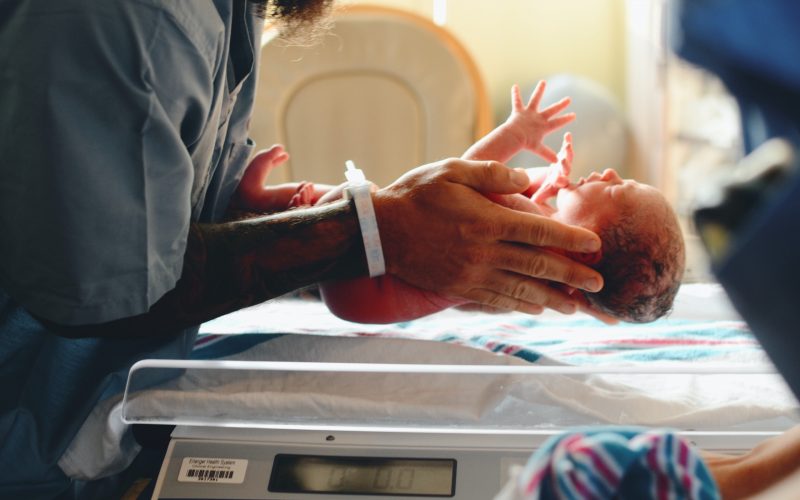Imagine you have a friend, Chloe, a lawyer who was prescribed pain meds after a car accident four years ago and ever since suffers from an unfortunate addiction to oxycodone. Chloe is also pregnant with her first child. When Chloe starts to go into labor, she arrives at St. Joseph’s Hospital and the nurses notice she seems drowsy, unable to recall who her OB/GYN is, and her breathing appears labored. The nurses rush Chloe to a delivery room where she gives birth.
Based on Chloe’s affect at the Hospital, the doctor orders a toxicology screen after the nurse conducts a routine newborn physical assessment. When the results come back positive for fentanyl exposure, the doctor fulfills his duty as a mandatory reporter under A.R.S. § 13-3620(E) and reports his findings to the Department of Child Safety (DCS).
When a health care professional determines that “an infant under 30 days of age was exposed prenatally to a substance listed in A.R.S. § 13-3401” and the exposure “was not a result of medical treatment” the infant is a Substance Exposed Newborn (SEN) [1]. A.R.S. § 13-3401 contains an exhaustive list of opiates and narcotics, including but not limited to: oxycodone, morphine, heroine, and fentanyl. Marijuana, may also trigger an SEN diagnosis.
SENs are not uncommon. In 2019, approximately 2,587 newborns were born substance exposed in Arizona. Of those, 899 were exposed to Narcotics/Hallucinogens and 461 were exposed to an unspecified noxious substance [2]. Nationally, according to the CDC, a self-reported survey from 2017 shows about 7% of pregnant women using pain relievers during pregnancy.
SENs are primarily identified by “clinical indicators in the prenatal period including maternal and newborn presentation, history of substance use/abuse, medical history, and/or toxicology results” [3]. While it used to be relatively easy to identify pregnant women with substance abuse issues, the demographics have changed significantly since Big Pharma introduced pill form opioids in the late 90s. No longer are addicts characterized by track marks and unkept appearances. Now, women like Chloe with high-paying jobs and stable housing have replaced the face of the opioid addict.
Therefore, Chloe’s demeanor, inability to name her OB/GYN, and apparent lack of prenatal care were the first indications that her baby was at risk of substance exposure. Mothers who display these behaviors and/or additional signs of being under the influence (dilated pupils, erratic behavior, itching arms, etc.) put the Hospital staff on notice.
Of course, first appearances may be misleading. To confirm their suspicions, doctors and nurses may order a toxicology screening, which occurs after a routine physical assessment of the child. If the infant displays signs of Neonatal Abstinence Syndrome (NAS) during the physical assessment, a newborn toxicology screening is recommended. Signs of NAS include irritability, high-pitched crying, and unexplained apnea [4].
If a toxicology screening is ordered, the doctor or nurse test the baby’s meconium, which is the first feces of a newborn infant. According to AZDHS, meconium Testing is the most reliable and noninvasive method for determining substance exposure and identifies “most substances used by the mother after 20 weeks, such as: cocaine, marijuana, opiates, barbiturates, benzodiazepines, 16 amphetamines, and PCP” [5].
If the toxicology results are positive and/or “the medical provider reasonably believes that a newborn infant may be affected by the presence of alcohol or a drug,” a report must be made to DCS pursuant to 13-3620(E). Some hospitals, such as Phoenix Children’s Hospital, employ social workers who must also report the SEN to DCS.
Once DCS receives a hotline call, a DCS Child Safety Specialist goes to the hospital and uses medical records and supporting documentation (i.e., the toxicology report and/or mother’s admission of drug use) to assess the risk level to the newborn. DCS reviews the information to determine if it has probable cause to believe the newborn was substance exposed, if temporary custody is clearly necessary to protect the infant from abuse or neglect (i.e. drug use), and if it is contrary to the child’s welfare to remain with the parents. During the investigation, DCS should also contact relatives of the Mother and any alleged Father to find family members capable of taking custody of the newborn.
If the newborn has been exposed to certain substances, such as methamphetamine or, in Chloe’s case, fentanyl, it is more likely that DCS will request a Court Order for removal. To request the Court Order, the DCS case worker fills out an Application and Declaration for Ex-Parte Removal of Child. The Application is immediately sent to a Judge for review and approval. In the Application, the DCS specialist describes the circumstances that support a probable cause determination that temporary custody is necessary to protect the child pursuant to A.R.S. § 8-821(A). If the Judge agrees with the finding, they issue an Order for Ex-Parte Removal of Child, also known as Court Authorized Removal (CAR).
In the alternative, if the parents are willing to sign a Voluntary Placement Agreement and the newborn is eligible to be accepted into voluntary placement that option can be vetted prior to court intervention [6]. Depending on the severity and type of exposure, DCS may also opt for an in-home Dependency, where the parents are allowed to be in the home with the Child with a responsible adult appointed by DCS to serve as a 24/7 safety monitor. The responsible adult is typically a friend or relative approved by DCS after passing both a DCS and DPS background check.
Once the DCS Specialist receives the Order, they will remove the SEN from the hospital unless the newborn is in the NICU or otherwise unable to be medically discharged. If the mother remains at the hospital after giving birth, they will not have access to the newborn. At some point during the investigation, DCS develops an Infant Care Plan (ICP) which addresses both the newborn and the mother’s needs and/or files a Dependency Petition [7]. As part of the ICP, DCS also provides the mother with substance abuse services as needed.
The dramatic rise in opioid addiction across the United States correlates with an increase in babies being born SEN. With the invention of pill opioids, addicts no longer present as “junkies” with their veins scarred from injections. Like Chloe, SENs can be born to addicts who are high functioning, yet highly addicted mothers. While DCS does and should take custody of SENs, aspects of the process are flawed. DCS lacks a quick, efficient mechanism for reunification. Often the drug programs and/or services provided to the mother are not catered to the individual and do not necessarily address the families’ overall needs (i.e., financial instability, employment, lack of transportation). Further, DCS fails to recognize that a high percentage of drug addicts are using to cope with underlying mental health issues and need counseling or other mental health services in conjunction with substance abuse treatment.
For women like Chloe, it is important to understand the steps that will be taken after giving birth. Separation from a newborn for any reason is an understandably traumatic event and for an individual already struggling with substance abuse it often leads to relapse or additional drug use. Hiring counsel can help ease the stress by creating a comprehensive plan for reunification but it is ultimately up to the mother to lean on family support and seek out substance abuse programs to get clean.
[1] https://extranet.azdcs.gov/DCSPolicy/Content/Practice%20Guides%20&%20Additional%20Info/Glossary.htm; See also A.R.S. § 8-201.25(c).
[2] https://pub.azdhs.gov/health-stats/hip/index.php?pg=drugs (see “Inpatient discharges related to noxious influences affecting the fetus by category, gender, race/ethnicity, and county of residence” (Table C2)).
[3] https://www.azdhs.gov/documents/prevention/womens-childrens-health/reports-fact-sheets/high-risk/sen_guidelines.pdf
[4] Id.at 14-15.
[5] Id.at 15.
[6] A.R.S. § 8-806;a Voluntary Placement Agreement authorizes DCS to place a child with a guardian, custodian, or in foster care for a temporary period, not to exceed ninety days.
[7]https://extranet.azdcs.gov/DCSPolicy/Content/Program%20Policy/02%20Investigation_Asssessment_Case%20Planning/CH2_S11_1%20Family%20Functioning%20Assessments%20Involving%20SEN.htm?Highlight=substance%20exposed
Deandra Arena is an attorney at Woodnick Law, PLLC. She previously was an Assistant Attorney General for the Protective Services Section (representing DCS) in Arizona. She is licensed to practice in Arizona and California.
Isabel Ranney is currently working at Woodnick Law as a law clerk and is in her second year of law school at Sandra Day O’Connor College of Law at Arizona State University.



